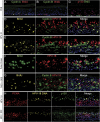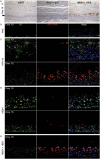Robust production and passaging of infectious HPV in squamous epithelium of primary human keratinocytes
- PMID: 19131434
- PMCID: PMC2648537
- DOI: 10.1101/gad.1735109
Robust production and passaging of infectious HPV in squamous epithelium of primary human keratinocytes
Abstract
Using Cre-loxP-mediated recombination, we established a highly efficient and reproducible system that generates autonomous HPV-18 genomes in primary human keratinocytes (PHKs), the organotypic raft cultures of which recapitulated a robust productive program. While E7 promoted S-phase re-entry in numerous suprabasal differentiated cells, HPV DNA unexpectedly amplified following a prolonged G2 arrest in mid- and upper spinous cells. As viral DNA levels intensified, E7 activity diminished and then extinguished. These cells then exited the cell cycle to undergo virion morphogenesis. High titers of progeny virus generated an indistinguishable productive infection in naïve PHK raft cultures as before, never before achieved until now. An immortalization-defective HPV-18 E6 mutant genome was also characterized for the first time. Numerous cells accumulated p53 protein, without inducing apoptosis, but the productive program was severely curtailed. Complementation of mutant genomes by E6-expressing retrovirus restored proper degradation of p53 as well as viral DNA amplification and L1 production. This system will be invaluable for HPV genetic dissection and serves as a faithful ex vivo model for investigating infections and interventions.
Figures







Comment in
-
Human papillomaviruses: a growing field.Genes Dev. 2009 Jan 15;23(2):138-42. doi: 10.1101/gad.1765809. Genes Dev. 2009. PMID: 19171777 Free PMC article.
References
-
- Banerjee N.S., Chow L.T., Broker T.R. Retrovirus-mediated gene transfer to analyze HPV gene regulation and protein functions in organotypic ‘raft’ cultures. Methods Mol. Med. 2005;119:187–202. - PubMed
-
- Bertrand P., Saintigny Y., Lopez B.S. p53's double life: Transactivation-independent repression of homologous recombination. Trends Genet. 2004;20:235–243. - PubMed
-
- Buck C.B., Pastrana D.V., Lowy D.R., Schiller J.T. Generation of HPV pseudovirions using transfection and their use in neutralization assays. Methods Mol. Med. 2005a;119:445–462. - PubMed
-
- Campo M.S. Animal models of papillomavirus pathogenesis. Virus Res. 2002;89:249–261. - PubMed
Publication types
MeSH terms
Substances
Grants and funding
LinkOut - more resources
Full Text Sources
Other Literature Sources
Research Materials
Miscellaneous
